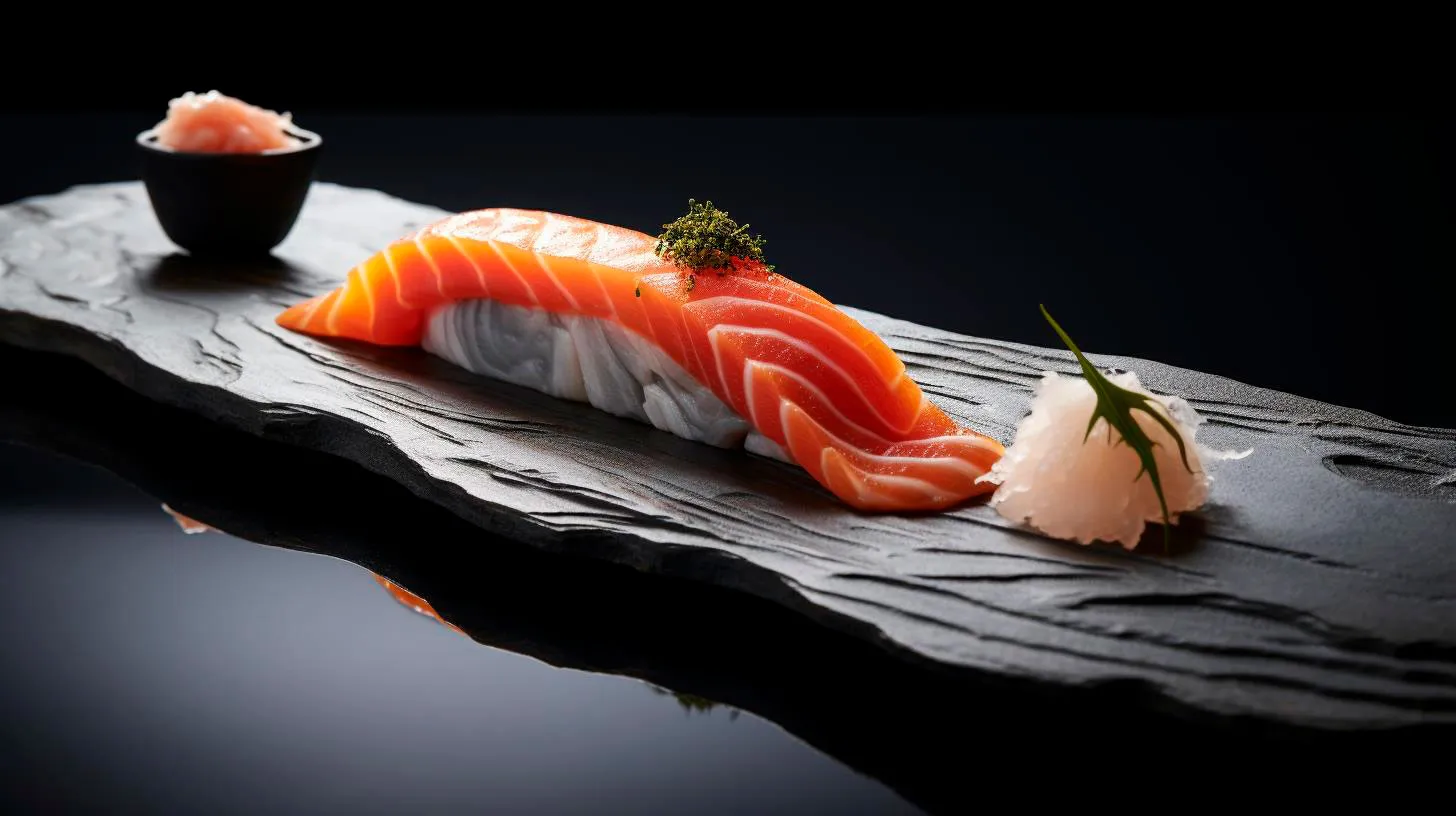Sushi Secrets: Unveiling the Journey to Sustainable Success
In this article, we will delve into the hidden secrets of the sushi journey and explore how sustainable practices have become essential for the long-term success of this beloved cuisine.
The Rise of Sushi Culture
The journey of sushi began centuries ago in Japan. Initially, sushi was a rather humble street food, comprising fermented fish wrapped in rice and preserved with salt. However, sushi has evolved over time and has gained immense popularity across the globe. According to recent statistics:
- The global sushi market is estimated to reach $22 billion by 2025, with a compound annual growth rate (CAGR) of 4.2%.
- In the United States alone, sushi consumption has doubled in the last decade, with Americans spending around $3.1 billion on sushi annually.
The sushi culture has not only revolutionized the culinary world but has also introduced various economic opportunities. Yet, as sushi gained popularity, it also faced significant challenges, particularly in terms of sustainability.
Sustainable Sourcing: A Key Ingredient
When it comes to sushi, sustainability is not limited to just taste and presentation. It encompasses responsible sourcing, which plays a crucial role in ensuring the longevity of the sushi industry. Here are some key aspects of sustainable sourcing:
1. Responsible Fishing
Overfishing has posed a severe threat to marine ecosystems worldwide. To combat this, the sushi industry has started embracing responsible fishing practices:
- Adoption of fishing methods, such as pole-and-line or handline, that minimize bycatch and prevent the depletion of vulnerable species.
- Supporting sustainable fishing initiatives, like the Marine Stewardship Council (MSC), which certifies fisheries that meet strict sustainability criteria.
2. Embracing Farmed Fish
Farmed fish, when sourced sustainably, can offer a more environmentally friendly solution. The sushi industry has recognized this and is increasingly relying on responsibly farmed fish:
- Encouraging the use of eco-friendly aquaculture techniques that reduce the impact on local ecosystems.
- Promoting the consumption of farmed species, like salmon or shrimp, that have lower mercury levels and are less susceptible to overfishing.
3. Reducing Food Waste
Food waste is a significant issue globally, and the sushi industry has taken steps to minimize its impact:
- Implementing portion control practices to reduce excessive food waste.
- Utilizing unsold fish creatively, such as repurposing as ingredients in other dishes or making fish-based broths and stocks.
Sustainable Packaging: Wrapping the Future
While sustainable sourcing is crucial, the sustainability journey of sushi extends beyond the fish on your plate. The packaging used plays a significant role in reducing waste and environmental impact. Here’s how the sushi industry is tackling this challenge:
1. Biodegradable Packaging Materials
Many sushi establishments are shifting towards biodegradable packaging materials to minimize their carbon footprint:
- Replacing traditional plastic containers with biodegradable options made from materials like sugarcane or cornstarch.
- Switching to eco-friendly packaging materials that can be easily degraded without causing harm to the environment.
2. Sustainable Chopsticks
Disposable chopsticks made from wood or bamboo have contributed to deforestation. To overcome this issue, sustainable alternatives have emerged:
- Introduction of reusable and durable chopsticks made from sustainable materials like stainless steel or bamboo.
- Promotion of personal chopsticks, encouraging customers to bring their own, thus reducing waste generated by disposable chopsticks.
The Advantages of Sustainable Sushi
Sustainable sushi practices not only benefit the environment and marine ecosystems but also offer various advantages to sushi establishments and consumers alike:
1. Enhanced Reputation and Customer Loyalty
By prioritizing sustainability, sushi restaurants can differentiate themselves from competitors and attract environmentally conscious customers. This fosters customer loyalty and improves brand reputation.
2. Cost-Efficiency in the Long Run
Implementing sustainable practices may require initial investments, but in the long run, they can lead to cost savings:
- Reducing waste minimizes disposal costs and the need for excessive packaging.
- Decreasing reliance on overfished species helps avoid potential price spikes due to scarcity.
3. Preservation of Biodiversity
Sustainable sourcing ensures that future generations can enjoy sushi without depleting marine biodiversity. By supporting responsible fishing practices, we contribute to the preservation of diverse marine ecosystems.
Key Takeaways
The journey to sustainable success in the sushi industry involves responsible sourcing and packaging practices, as well as the active participation of sushi establishments and consumers. Remember these important points:
- Sustainable sourcing entails responsible fishing, embracing farmed fish, and reducing food waste.
- Sustainable packaging involves using biodegradable materials and promoting sustainable chopstick alternatives.
- Sustainable sushi practices offer advantages such as enhanced reputation, cost-efficiency, and the preservation of biodiversity.
As sushi lovers, let’s strive to support sustainable sushi establishments and adopt eco-friendly habits. By unveiling the secrets to sustainable success, we can indulge in our favorite sushi guilt-free, knowing we are contributing to a better future for our planet.
Rising Above: How the Sushi Industry Overcomes its Biggest Challenges
From sourcing high-quality ingredients to maintaining the delicate balance of tradition and innovation, the sushi industry has found ways to rise above these hurdles with resilience and adaptability.
1. Sourcing Sustainable and Fresh Ingredients
One of the biggest challenges faced by the sushi industry is sourcing high-quality and sustainable ingredients consistently. With concerns over overfishing and environmental impact, sushi chefs and restaurateurs find themselves in a constant pursuit of responsibly sourced seafood.
- Feature: Conscious Sourcing
- Advantage: Enhanced Reputation
By partnering with reputable suppliers and closely monitoring fishing practices, the sushi industry strives to reduce its ecological footprint. Collaborations with organizations like the Marine Stewardship Council (MSC), which certifies sustainable fisheries, have become increasingly prevalent.
Restaurants and businesses that prioritize sustainable sourcing can showcase their commitment to environmental conservation. This, in turn, appeals to a growing number of eco-conscious consumers who value businesses that align with their values.
2. Preserving Traditional Techniques
While sushi has evolved over the years to cater to diverse tastes, preserving the authenticity and artistry of this culinary tradition remains critical. Sushi chefs face the challenge of balancing innovation with the preservation of traditional techniques.
- Feature: Mastering Time-honored Methods
- Advantage: Exquisite Culinary Experience
Through rigorous training and apprenticeships, sushi chefs acquire the skills necessary to uphold traditional sushi-making techniques. They embrace the discipline and precision required to create sushi that respects the centuries-old craft, ensuring its continued legacy.
By adhering to traditional methods, sushi chefs elevate the dining experience, creating a sense of cultural authenticity. This commitment to preserving the art of sushi making helps establishments differentiate themselves and attract discerning customers.
3. Meeting the Demands of Safety and Hygiene
Food safety and hygiene standards are vital concerns for any cuisine, but sushi’s raw ingredients and delicate preparation demand an extra level of care. The industry faces the challenge of maintaining impeccable quality in every aspect of the sushi-making process.
- Feature: Stringent Quality Control
- Advantage: Customer Confidence
Sushi restaurants and suppliers implement strict quality control measures to ensure the safety and freshness of their ingredients. This includes regular testing, proper storage techniques, and adherence to health regulations.
When diners know that their health and well-being are prioritized through rigorous safety practices, they develop trust in the establishment. This level of confidence not only ensures repeat business but also positive word-of-mouth recommendations.
4. Embracing Technological Advancements
Technology has revolutionized nearly every industry, and sushi is no exception. From automated sushi machines to online delivery platforms, the industry faces the challenge of incorporating tech advancements while preserving its human touch.
- Feature: Automated Sushi Machines
- Advantage: Improved Efficiency and Consistency
Innovations like sushi-making robots and automated rice cookers streamline the sushi production process without compromising quality. This not only increases efficiency but also reduces labor costs.
By leveraging technology, sushi restaurants can serve customers more quickly and consistently. This leads to higher customer satisfaction and the ability to handle larger orders during peak hours.
Key Takeaways
The sushi industry continues to overcome its biggest challenges by:
- Prioritizing sustainable sourcing to reduce environmental impact
- Preserving traditional sushi-making techniques to maintain its authenticity
- Maintaining stringent food safety and hygiene practices
- Embracing technological advancements to enhance efficiency without sacrificing quality
In the face of these obstacles, the sushi industry’s ability to adapt and innovate is a testament to its enduring success. By addressing these challenges head-on, sushi businesses can continue to delight customers with their artful creations and ensure the longevity of this cherished cuisine.
Feeding the Future: Navigating the Sushi Path to a Sustainable World
In this article, we delve deeper into the world of sushi, its impact on the environment, and the steps being taken to create a sustainable future for this popular delicacy.
The Environmental Impact of Sushi
Sushi, originating from Japan, has gained immense popularity worldwide. The consumption of sushi has risen significantly over the past few decades, leading to increased demand for raw fish such as tuna, salmon, and shrimp. However, the global appetite for sushi has put immense pressure on already depleted fish stocks and has resulted in overfishing and habitat destruction. Here are some key statistics highlighting the environmental impact of the sushi industry:
- Over 70% of the world’s fish species are fully or over-exploited due to commercial fishing practices.
- Tuna, a staple in many sushi dishes, is considered a severely threatened species, with some populations declining by 90% over the past century.
- Shrimp production for sushi has resulted in the destruction of coastal ecosystems, including mangroves, which are vital for marine biodiversity and carbon sequestration.
The Roadmap to Sustainable Sushi
Despite the challenges, the sushi industry has recognized the need for change and is taking steps towards sustainability. Here are some key initiatives and practices that are being adopted:
1. Sustainable Sourcing:
Restaurants and sushi chefs are increasingly prioritizing sustainably sourced seafood. This means collaborating with suppliers that follow responsible fishing practices, such as using selective fishing gear and avoiding endangered species. By choosing sustainably sourced seafood, the industry can support fish populations to recover and ensure long-term availability of our favorite sushi ingredients.
2. Traceability and Certification:
The sushi industry is embracing traceability systems to ensure transparency and accountability in the seafood supply chain. Certifications like the Marine Stewardship Council (MSC) and Aquaculture Stewardship Council (ASC) help consumers identify sushi made from sustainable sources. By choosing certified sushi, consumers can contribute to the protection of our oceans and reward responsible fishing practices.
3. Embracing Alternative Ingredients:
Recognizing the strain on fish stocks, sushi chefs are exploring alternative ingredients to diversify their menus. From plant-based options like avocado and cucumber to innovative substitutes like tofu and seaweed, these alternatives reduce the reliance on traditional seafood and create more sustainable sushi choices.
The Benefits of Sustainable Sushi
Transitioning the sushi industry towards sustainability not only benefits the environment but also offers numerous advantages:
- Preserving Marine Ecosystems: By adopting sustainable fishing practices, we can protect marine biodiversity and preserve delicate ecosystems.
- Securing Future Fish Supply: Sustainable sushi practices ensure the availability of seafood for future generations.
- Consumer Choice: Sustainable sushi provides consumers with the power to make informed choices and support practices aligned with their values.
- Enhancing Reputation: Restaurants and chefs known for serving sustainable sushi gain a competitive edge and attract eco-conscious customers.
In Conclusion: Sushi Shaping a Sustainable Future
Sushi, a delicacy deeply ingrained in many cultures, presents a unique opportunity to reshape our food systems for a sustainable future. By adopting sustainable sourcing, traceability, and embracing alternative ingredients, the sushi industry can contribute to the preservation of marine ecosystems and secure a future where sushi remains a beloved and sustainable cuisine. As consumers, we play a crucial role in demanding sustainable options and supporting responsible practices.
Let us embark on this journey together, where sushi not only satisfies our taste buds but also feeds the future.
From Tuna Troubles to Eco-Warriors: The Sustainable Evolution of Sushi
Thankfully, a new wave of eco-warriors has emerged, championing sustainable alternatives and inspiring a positive change within the sushi community.
The Troubles with Tuna
One of the key issues plaguing the sushi industry is the overfishing of tuna. As demand for this prized fish has grown, so has the pressure on tuna populations. Statistics show that approximately 90% of the world’s tuna stocks are either fully exploited or overfished, putting the future of this species at risk.
Thankfully, this unsustainable practice is being addressed through innovative solutions. Some sushi chefs and restaurants are choosing to replace traditional tuna with alternative fish species that are more abundant and have a lower impact on the environment. This shift helps to preserve the delicate balance of our oceans while still offering sushi lovers a delectable dining experience.
The Rise of Sustainable Seafood
Recognizing the urgency of the situation, eco-warriors within the sushi industry are actively promoting sustainable seafood practices. They understand that by making responsible choices, they can contribute to the preservation of marine ecosystems and ensure the long-term availability of their beloved cuisine.
One of the key initiatives gaining traction is the use of locally sourced, sustainable seafood. By focusing on fish species that are abundant in their respective regions, sushi chefs are reducing the carbon footprint associated with long-distance transportation. This not only benefits the environment, but also supports local fishermen and strengthens regional economies.
Embracing Plant-Based Sushi
Another exciting development in the sushi world is the rise of plant-based sushi options. As the demand for vegetarian and vegan choices continues to grow, sushi restaurants are getting creative with their offerings. By substituting traditional fish with ingredients like tofu, avocado, and even fruits, they are appealing to a broader range of customers while reducing their reliance on unsustainable fishing practices.
Plant-based sushi is not only environmentally friendly but also offers numerous health benefits. It is cholesterol-free, low in saturated fats, and packed with essential nutrients. By making this switch, sushi lovers can enjoy guilt-free dining experiences that are both delicious and nutritious.
The Key Takeaways
- Overfishing of tuna is a significant issue plaguing the sushi industry.
- Sustainable seafood practices are gaining momentum within the sushi community.
- Locally sourced, sustainable seafood reduces the carbon footprint associated with long-distance transportation.
- Plant-based sushi options are on the rise, appealing to a wider range of customers and promoting environmental sustainability.
- Sustainable sushi choices not only benefit the environment but also support local fishermen and strengthen regional economies.
The evolution of sushi towards sustainability is an encouraging trend. As eco-warriors continue to highlight the importance of responsible choices within the sushi industry, we can all play a part in preserving our oceans while enjoying the flavors we love. So, the next time you crave sushi, choose sustainably sourced options and contribute to the eco-warrior movement one bite at a time!


